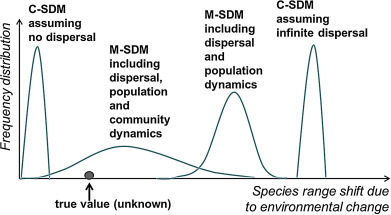Singer, A., Johst, K., Banitz, T., Fowler, M. S., Groeneveld, J., Gutierrez, A. G., et al. (2016). Community dynamics under environmental change: How can next generation mechanistic models improve projections of species distributions? Ecological Modelling, 326, 63-74.
DOI: 10.1016/j.ecolmodel.2015.11.007

In order to sustain biodiversity and ecosystem services we need predictive models that can reliably project the consequences of climate change and anthropogenic impacts on ecological communities. Currently several approaches exist to predict the impact of climate change on species. Correlative species distribution models relate observations of a species to the local environment and then predict how that distribution may be influenced by a changing environment. Mechanistic or process based models describe biotic and abiotic factors that mechanistically describe the individual and its response to climate change. Due to their structural difference correlative and mechanistic models are well suited to tackle different problems in species distribution modeling. This paper gives an overview of how biotic processes influence species distribution and how these processes alter the projections made by the model. The inclusion of biotic process has three consequences on modeling, (1) an increases in structural realism reflecting the mechanistic knowledge of the system improves model accuracy, (2) insufficient ecological knowledge about the process may increase parameter and structural uncertainty, (3) the additional complexity by incorporating the biotic process may increase uncertainty further. While incorporating relevant biotic processes are likely necessary to achieve the most accurate projects theoretically, if these processes are not adequately informed the added uncertainty could reduce accuracy and make model projections unreliable. In order to generate models that can reliably project into the future the authors present a protocol for incorporating data into a distribution model. First all relevant knowledge that could inform the projections of current and future species distributions. Next, parameterize all the relevant processes, and attempt to assess the consequences of uncertainty these parameter on you model projections. Next use an iterative loop to identify knowledge gaps and improve the models accuracy. Finally, they recommend communicating the evaluation and interpretation thoroughly to aid in advancement of mechanistic based approaches for large scale species distribution modeling. While mechanistic models may prove to be more accurate in some cases, often we find that the data or knowledge to build these models is insufficient. Correlative models are likely still sufficient particularly in cases where the only data available is presence locations with limited knowledge on the processes that influence the species.
